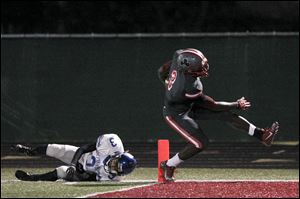
OHSAA adopts point-differential rule for high school football
5/23/2014
Ohio joins several other states in adopting a second-half running clock in lopsided football games.
COLUMBUS — The Ohio High School Athletic Association has adopted a point-differential rule for high school football.
It’s one of several regulations the OHSAA has approved in recent days, including passage of its competitive-balance issue.
Ohio thus joins several other states in adopting a second-half running clock in lopsided football games.
For years, high school football games in Ohio could be shortened by mutual agreement of both head coaches. That will change this fall with the adoption of a football point-differential rule as part of the 2014-15 sport regulations approved by the OHSAA Board of Directors at its May board meeting.
The point-differential regulation, which is already used in many states, is permitted by state adoption according to the National Federation of State High School Associations (NFHS).
The proposal was recommended to the board by the OHSAA staff after more than a year of consultation with the Ohio High School Football Coaches Association.
The OHSAA notes that, unlike changes to the bylaws and constitution — which require a vote of the membership — changes to sport-specific regulations and general sports regulations need only approval from the board of directors.
“First and foremost, this was proposed out of concern for player safety,” said Beau Rugg, the OHSAA’s assistant commissioner in charge of football, wrestling and all officiating. “Lopsided games aren’t good for anybody. The risk of injury goes up and it can be a tense situation for coaches and players. The length of games is also a topic of conversation at the national level. This is just the right thing to do.”
The football point-differential regulation reads as follows:
“After the first half, any time the score differential reaches 30 points or more for 11-man football, the following changes, and only these changes, will be made regarding rules determining when the clock will be stopped.
“The clock will be stopped when” an official’s time-out is called either for an injured player or following a change of team possession; a charged time-out is called; at the end of a period, or when a score occurs.
The clock will start again on the ready for play signal for the first play after the above situations.
The clock will continue to run in all other situations, and does not preclude the use of NFHS Rule 3-1-3, which reads: “A period or periods may be shortened in any emergency by agreement of the opposing coaches and referee. By mutual agreement of the opposing coaches and the referee, any remaining periods may be shortened at any time or the game terminated.”
The clock reverts to regular timing if/when the differential drops below 30 points.
“This takes the decision-making situation out of it for the coaches,” Rugg said. “That is often a tough situation for a coach to be in. Now, they can point to the rule instead of having to make that decision. Like all regulations, we will monitor this to see how it affects games.”